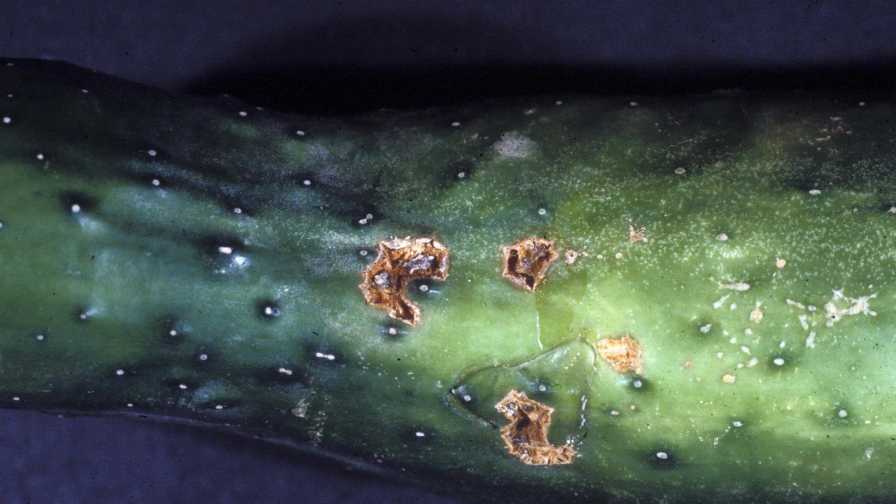Sidestepping Scab Critical For Florida Cucurbit Growers
Crops Affected
Caused by the fungus Cladosporium cucumerinum, scab is a disease that affects cucurbits such as cantaloupe, pumpkin, and squash but mainly infects cucumber. Watermelon is highly resistant to scab. Susceptible cucumber varieties have sustained 50% or greater yield loss during prolonged cool, moist weather.

Photo courtesy of University of Georgia Plant Pathology
Identification
Leaf symptoms initially appear as numerous small, pale green, water-soaked spots. These spots gradually turn grayish white and become angular. Lesions often are surrounded by a yellowish halo. Eventually, the dead leaf tissue splits and falls out, leaving a ragged hole in the leaf. Under humid conditions, a velvety, silver-gray mold that turns olive-green might develop. Although scab can attack any above-ground part of the plant, injury to the fruit is most noticeable.
Fruit can be infected at all stages of growth. Spots first appear as gray, sunken areas about 1/8 inch in diameter from which a sticky substance may ooze. The spots grow darker with age and gradually become sunken. On mature fruit, lesions tend to be superficial and might appear as brown corky scabs. Affected fruit often are invaded by soft-rotting bacteria that produces a mushy, foul-smelling decay. On highly resistant fruits, especially on certain squashes and pumpkins, irregular knob-like formations may develop. Infections established in the field continue to develop postharvest.
Survival And Spread
The scab fungus survives on seed and in crop debris. Temperatures between 59°F and 77°F, accompanied by moist weather with frequent fogs, heavy dews, and light rains are most favorable for scab development. Under these conditions, spores are produced and spread locally by splashing rain, by equipment or workers moving through the field, or long distance by moist air currents. Secondary disease cycles can occur as long as the weather remains favorable. Spots are produced soon after the fungus begins to sporulate.
Management Methods
Losses to scab can be reduced through an integrated disease management program. Growers should use high-quality, disease-free seed from a reputable seed source. Resistant cucumber varieties are available and should be employed if scab is a concern.
Sanitation is essential since the fungus might survive in crop litter and crop residue should be thoroughly incorporated into the soil to enhance rapid breakdown.
Crop rotation is important, and land where cantaloupes, cucumbers, pumpkins, or squash have been grown within the past three years should be avoided.
Timely fungicide applications can reduce the severity of scab. During cool wet weather, fungicide sprays should be applied every five days rather than weekly. Early applications should begin when first true leaves appear or soon after transplanting.
Postharvest wash water should be chlorinated to reduce postharvest infection. Water temperature and pH should be adjusted for maximum benefit.
Consult UF/IFAS recommendations for currently labeled fungicides for scab control in Florida cucurbits.










